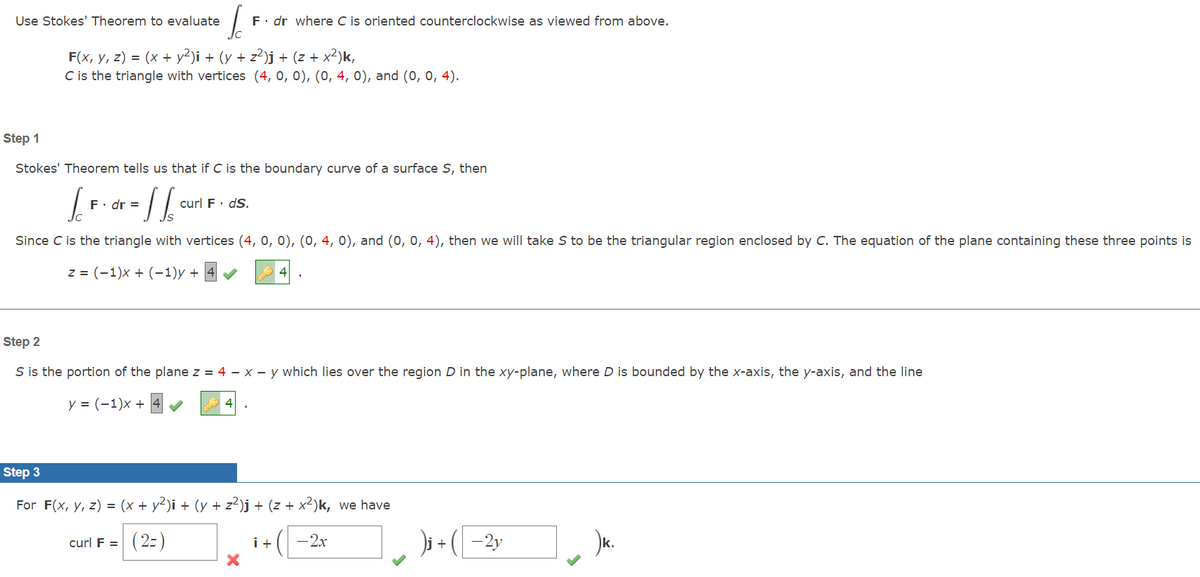I F. dr where C is oriented counterclockwise as viewed from above. F(x, y, z) = (x + y2)i + (y + z²)j + (z + x²)k, C is the triangle with vertices (4, 0, 0), (0, 4, 0), and (0, 0, 4). Step 1 Stokes' Theorem tells us that if C is the boundary curve of a surface S, then [ F. dr = £ £₂ curl F. ds. Since C is the triangle with vertices (4, 0, 0), (0, 4, 0), and (0, 0, 4), then we will take S to be the triangular region enclosed by C. The equation of the plane containing these three points is z = (-1)x+ (-1)y + ✓ Step 2 S is the portion of the plane z = 4 - x - y which lies over the region D in the xy-plane, where D is bounded by the x-axis, the y-axis, and the line y = (-1)x+ Step 3 For F(x, y, z) = (x + y²)i + (y + z²)j + (z + x²)k, we have curl F = (2=) i + -2x )j + (−2y )k. x Use Stokes' Theorem to evaluate
I F. dr where C is oriented counterclockwise as viewed from above. F(x, y, z) = (x + y2)i + (y + z²)j + (z + x²)k, C is the triangle with vertices (4, 0, 0), (0, 4, 0), and (0, 0, 4). Step 1 Stokes' Theorem tells us that if C is the boundary curve of a surface S, then [ F. dr = £ £₂ curl F. ds. Since C is the triangle with vertices (4, 0, 0), (0, 4, 0), and (0, 0, 4), then we will take S to be the triangular region enclosed by C. The equation of the plane containing these three points is z = (-1)x+ (-1)y + ✓ Step 2 S is the portion of the plane z = 4 - x - y which lies over the region D in the xy-plane, where D is bounded by the x-axis, the y-axis, and the line y = (-1)x+ Step 3 For F(x, y, z) = (x + y²)i + (y + z²)j + (z + x²)k, we have curl F = (2=) i + -2x )j + (−2y )k. x Use Stokes' Theorem to evaluate
Linear Algebra: A Modern Introduction
4th Edition
ISBN:9781285463247
Author:David Poole
Publisher:David Poole
Chapter4: Eigenvalues And Eigenvectors
Section4.2: Determinants
Problem 13AEXP
Related questions
Question

Transcribed Image Text:6
F. dr where C is oriented counterclockwise as viewed from above.
F(x, y, z) = (x + y²)i + (y + z²)j + (z + x²)k,
C is the triangle with vertices (4, 0, 0), (0, 4, 0), and (0, 0, 4).
Step 1
Stokes' Theorem tells us that if C is the boundary curve of a surface S, then
1₁ F. dr = 1₁
curl F. ds.
Since C is the triangle with vertices (4, 0, 0), (0, 4, 0), and (0, 0, 4), then we will take S to be the triangular region enclosed by C. The equation of the plane containing these three points is
z = (-1)x+ (-1)y +
Step 2
S is the portion of the plane z = 4 - x - y which lies over the region D in the xy-plane, where D is bounded by the x-axis, the y-axis, and the line
y = (-1)x+
Step 3
For F(x, y, z) = (x + y²)i + (y + z²)j + (z + x²)k, we have
curl F = (2=)
i+
- 2x
- 2y
k.
X
Use Stokes' Theorem to evaluate
Expert Solution
This question has been solved!
Explore an expertly crafted, step-by-step solution for a thorough understanding of key concepts.
This is a popular solution!
Trending now
This is a popular solution!
Step by step
Solved in 2 steps with 2 images

Recommended textbooks for you

Linear Algebra: A Modern Introduction
Algebra
ISBN:
9781285463247
Author:
David Poole
Publisher:
Cengage Learning

Elements Of Modern Algebra
Algebra
ISBN:
9781285463230
Author:
Gilbert, Linda, Jimmie
Publisher:
Cengage Learning,

Algebra & Trigonometry with Analytic Geometry
Algebra
ISBN:
9781133382119
Author:
Swokowski
Publisher:
Cengage

Linear Algebra: A Modern Introduction
Algebra
ISBN:
9781285463247
Author:
David Poole
Publisher:
Cengage Learning

Elements Of Modern Algebra
Algebra
ISBN:
9781285463230
Author:
Gilbert, Linda, Jimmie
Publisher:
Cengage Learning,

Algebra & Trigonometry with Analytic Geometry
Algebra
ISBN:
9781133382119
Author:
Swokowski
Publisher:
Cengage

Elementary Geometry For College Students, 7e
Geometry
ISBN:
9781337614085
Author:
Alexander, Daniel C.; Koeberlein, Geralyn M.
Publisher:
Cengage,